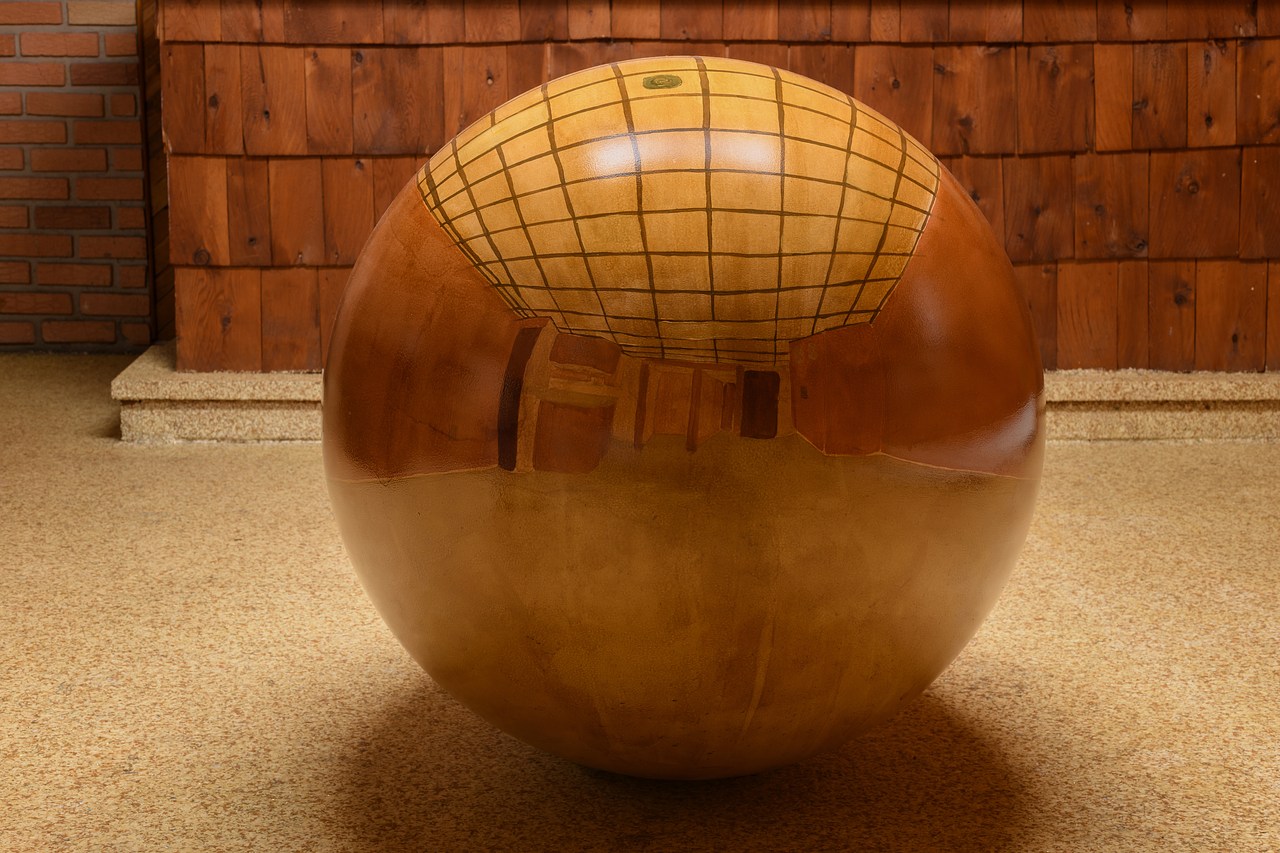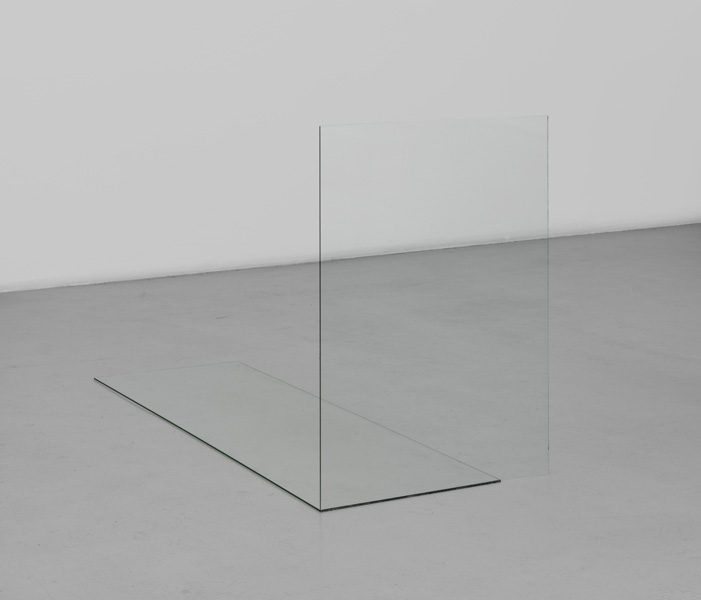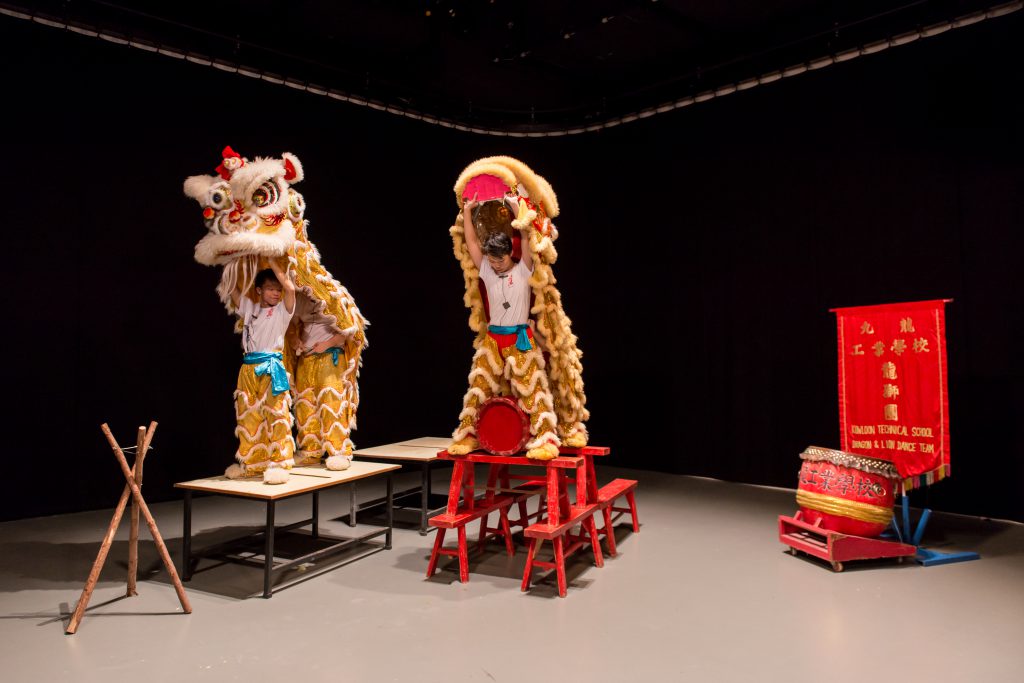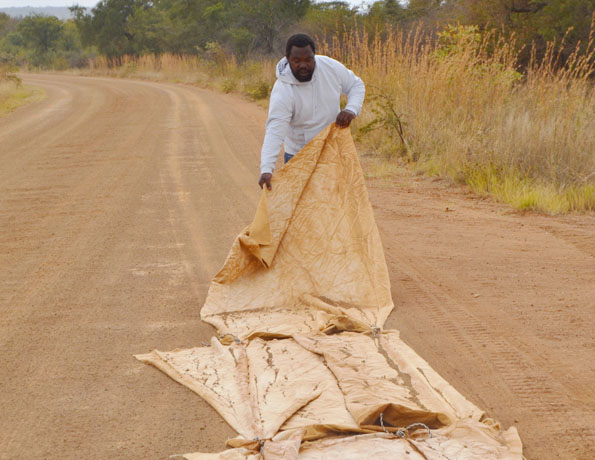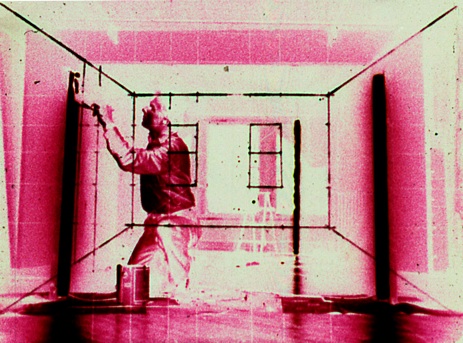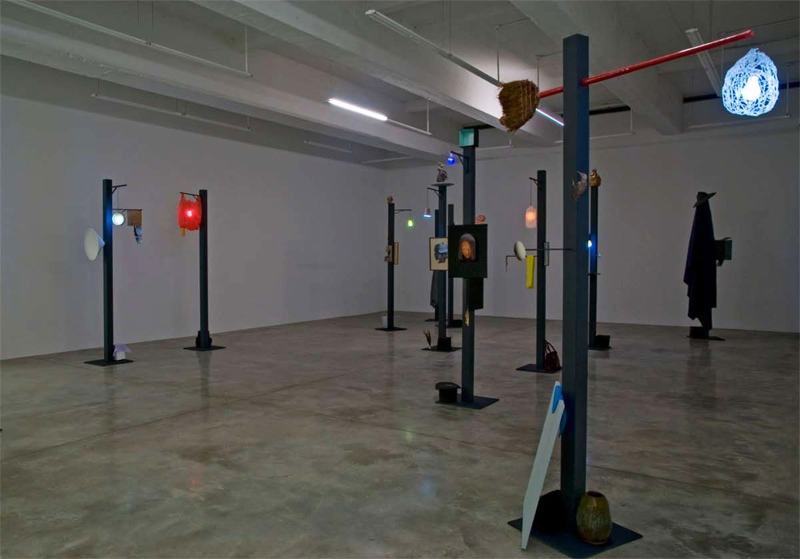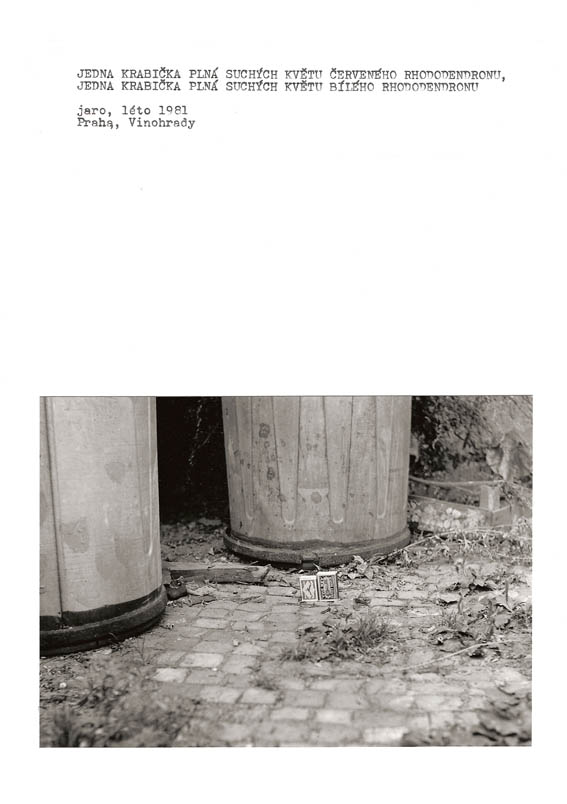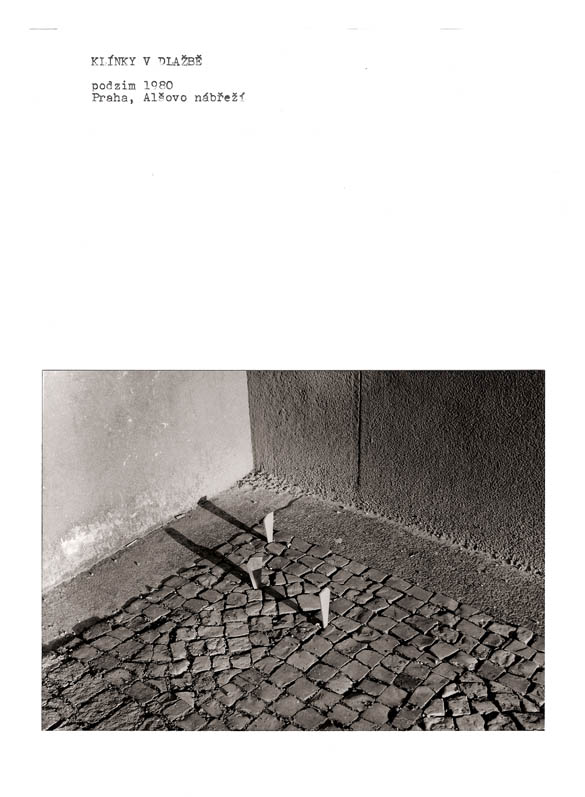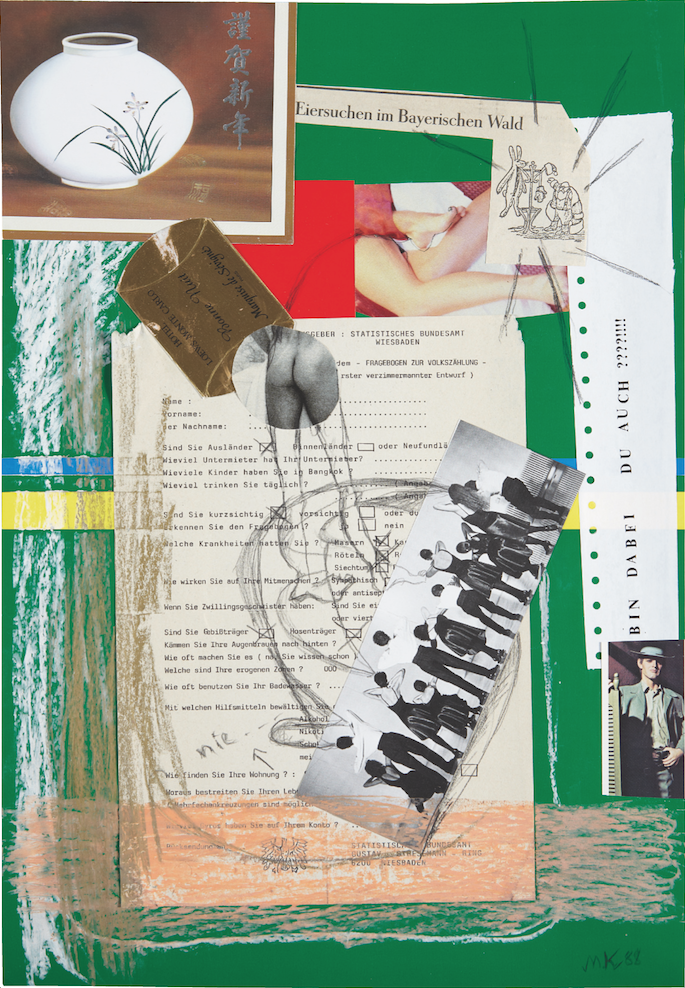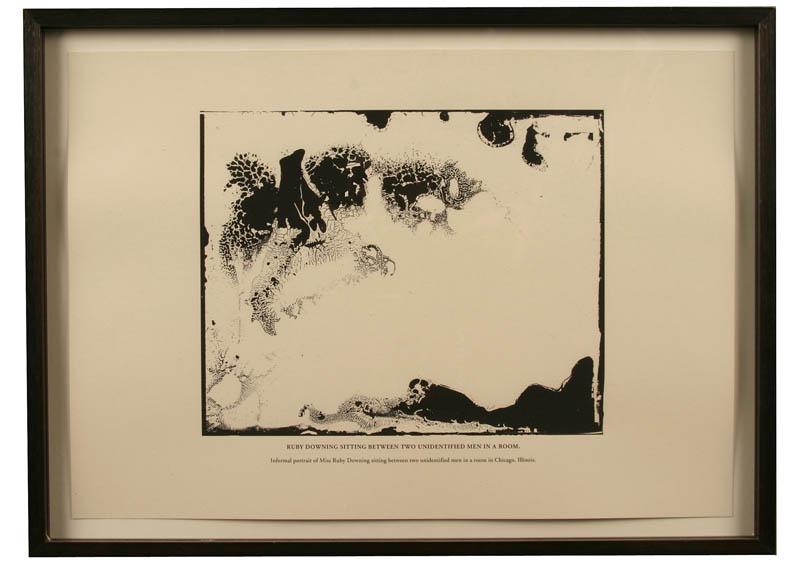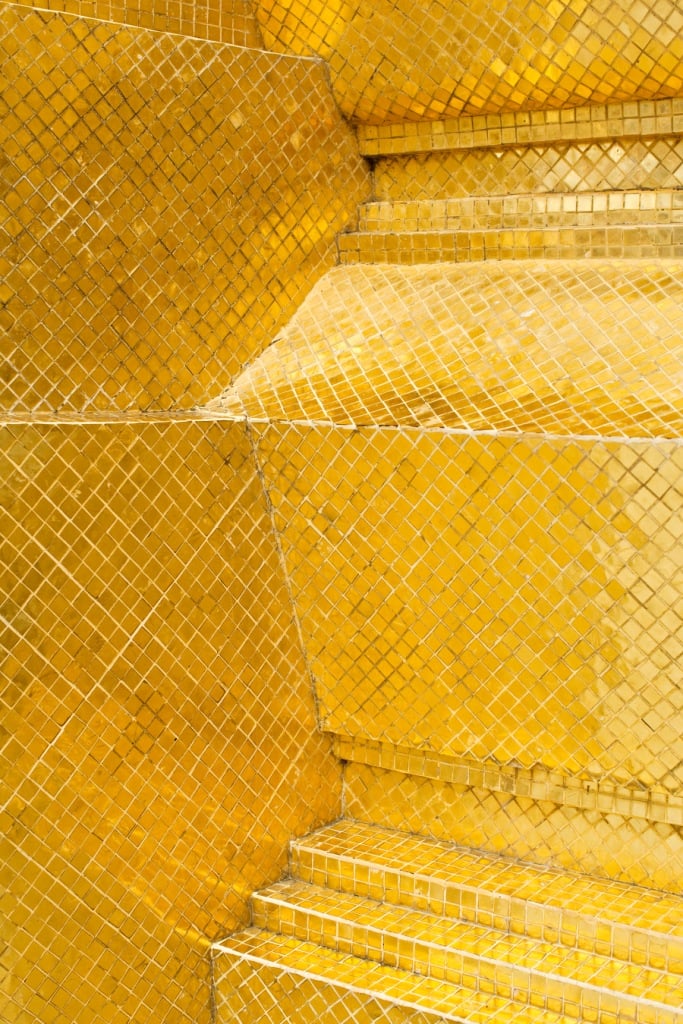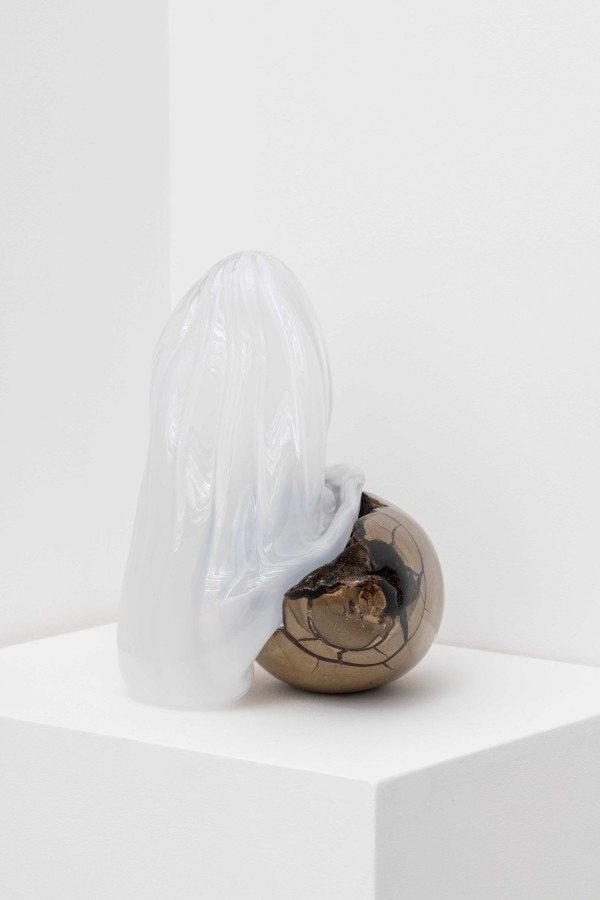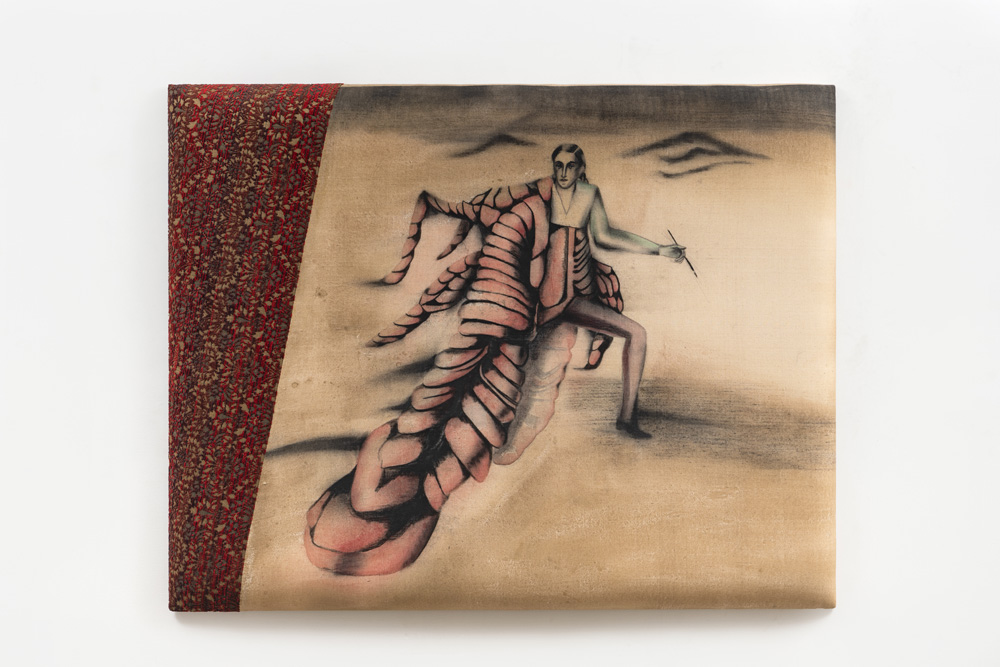
© » KADIST
Nontawat Numbenchapol
The series of prints titled Mr. Shadow by Nontawat Numbenchapol engages with the history of and current state of militarization in Thailand. Each print features an invisible person, their silhouette only outlined by the military fatigues that they wear.
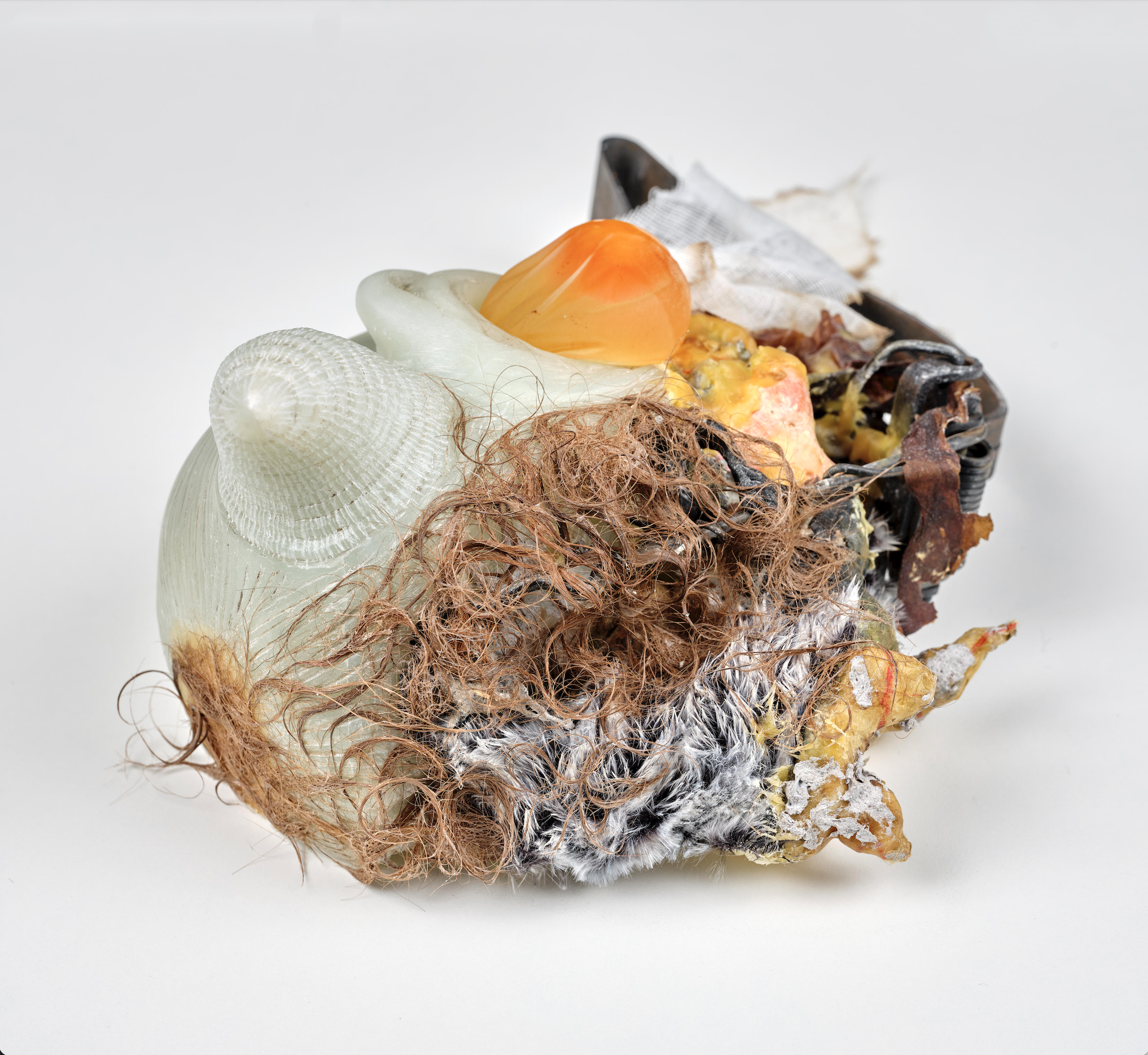
© » KADIST
Catalina Ouyang
font VII by Catalina Ouyang is part of an ongoing series of ‘fonts’, or sculptures, inspired by Catholic holy water vessels. This particular iteration from the series combines hand-carved soapstone, a stop loss trap, horse hair, fermented egg, and other elements to create an artwork that defies categorization. The work’s most notable feature is a small cavity that cradles a naked egg—a translucent, flaccid egg without its outer shell.

© » KADIST
Yu Ji
Flesh in Stone – Ghost No. 1 is a stunning series of cement made body parts in various scales and movements, along with components such as iron and plaster molds to emphasize their tension. The “incompleteness” of Flesh in Stone weakens the figurative image itself, thus shifting the viewer’s focus onto the relationship between the rough material and the ideal rounded body shapes.

© » KADIST
Nontawat Numbenchapol
The series of prints titled Mr. Shadow by Nontawat Numbenchapol engages with the history of and current state of militarization in Thailand. Each print features an invisible person, their silhouette only outlined by the military fatigues that they wear.

© » KADIST
Baseera Khan
Designed by the artist and fabricated in collaboration with Kashmiri artisans in India, Baseera Khan’s Psychedelic Prayer Rugs combine visual iconography traditional to Islam, such as the crescent moon and lunar calendar, with brightly coloured symbols of personal significance to the artist: a pair of embroidered sneakers, a fragment of an Urdu poem, and the Purple Heart medal. Visually seductive yet charged with political and symbolic associations, the rugs bridge elements of American popular culture with aspects of Islamic worship that may be poorly understood in contemporary secular contexts. Encouraged by Khan to take their shoes off and interact with the rugs, viewers participate in a decolonizing process as they meditate on their poetic allusions or perform the traditional salat, the daily prayers that constitute one of the five pillars of Islam, the others being faith, charity, fasting, and pilgrimage to Mecca.

© » KADIST
Markus Amm
A combination of planning and improvisation, control and lack of control, this painting is typical of Amm’s work. With its intimations of the sublime and reference to the works of Ad Reinhardt and Mark Rothko this painting extends the Romantic and modernist traditions in a perceptive way. These are subtle, slow, delicate paintings that evolve over a period of time—the product of long periods of contemplation.

© » KADIST
Laura Gannon
The impressionistic surface of Wild Money (2017) recalls the 1950s paintings of Philip Guston. Its creases recall human skin, while the filigree pattern of red skeins implies what lies beneath. The body is fully implicated in this work.

© » KADIST
Matthew Langan-Peck
Plane is an inflatable sculpture in the shape of an aeroplane made from numerous pieces of plastic bags assembled by an iron. The object is inflated by a fan at the structures base and deflates when it is deprived of its power source, causing the plane to sink. It is in this process that plane leans on its wings, evoking a crash, a defeat, or a failure.

© » KADIST
Baseera Khan
Designed by the artist and fabricated in collaboration with Kashmiri artisans in India, Baseera Khan’s Psychedelic Prayer Rugs combine visual iconography traditional to Islam, such as the crescent moon and lunar calendar, with brightly coloured symbols of personal significance to the artist: a pair of embroidered sneakers, a fragment of an Urdu poem, and the Purple Heart medal. Visually seductive yet charged with political and symbolic associations, the rugs bridge elements of American popular culture with aspects of Islamic worship that may be misunderstood in contemporary secular contexts. Encouraged by Khan to take their shoes off and interact with the rugs, viewers participate in a decolonizing process as they meditate on their poetic allusions or perform the traditional salat, the daily prayers that constitute one of the five pillars of Islam, the others being faith, charity, fasting, and pilgrimage to Mecca.
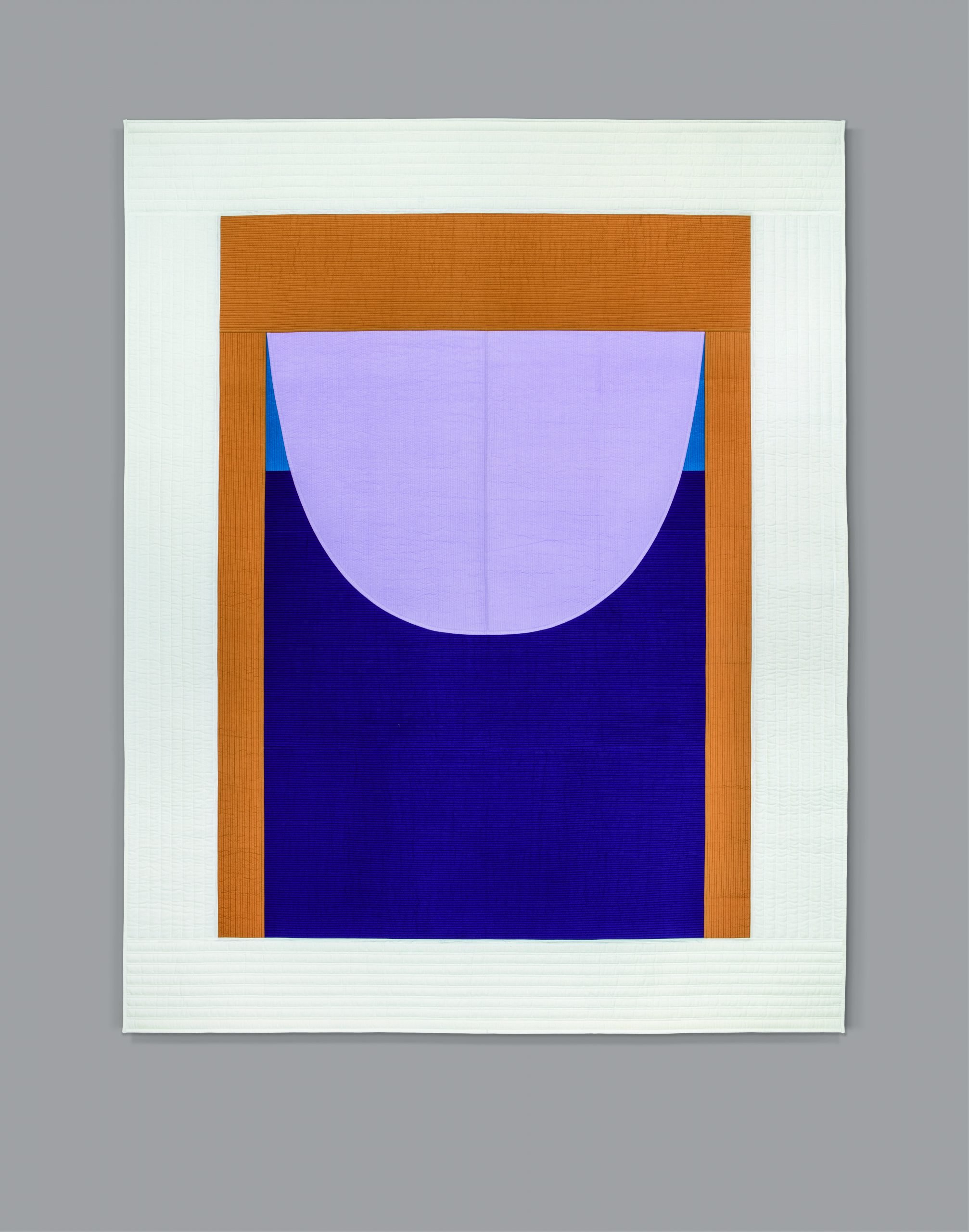
© » KADIST
Seulgi Lee
The Korean title for U: Repair the cowshed after losing the cow = Too late is —a famous Korean proverb meaning “you are doing something when you are already late to do it”. This work by Seulgi Lee is a nubi (traditional Korean quilt) blanket project that shows Korean proverbs expressed as geometric shapes. Nubi blankets were used as single sheet summer blankets in Korean households until the 1980s.

© » KADIST
Alicia Henry
Out of simple materials, Alicia Henry creates enigmatic, somewhat troubled characters, which reveal her interest in the complexities and the contradictions surrounding familial relationships. The artist probes societal differences and how these variations affect individual and group responses to themes of beauty, the body, and broader issues of identity. Untitled explores these themes and addresses the processes through which women navigate such issues.

© » KADIST
Vivian Suter
Vivian Suter paints her canvases and then allows them to come in contact with natural elements. For thirty years she has lived in isolation in the Guatemalan jungle, accumulating canvases, sometimes leaving them out for long periods of time. As a result, Suter does not title or date her paintings.

© » KADIST
Yo Daham
Yo Daham has been knitting, which he initially took up as a daily pastime, to produce objects that function as an incense burner by releasing smoke. His questioning of the nature of matter led to this unusual combination of knitting (typically considered a form of two-dimensional weaving) and an incense burner (an object traditionally used in rituals). Knitting is an act that requires unwinding a spool infinitely wrapped with thread and determining the form by applying force and pressure.

© » KADIST
Nao Bustamante
Silver & Gold combines video, performance, and original costumes into a self-proclaimed “filmformance” that evokes the legendary filmmaker Jack Smith and his tribute to 1940s Dominican movie starlet Maria Montez in a magical and joyfully twisted exploration of race, glamour, sexuality, and the silver screen. Taking Smith’s interest in Hollywood’s obsession with the reproduction of the exotic as a point of departure, Bustamante embodies Miss Montez. Here, video and the body function as both material and subject in her bizarre search for the new bejeweled body part that is at once her curse and oracle.

© » KADIST
Martin Creed
This photograph of Martin Creed himself was used as the invitation card for a fundraising auction of works on paper at Christie’s South Kensington in support of Camden Arts Centre’s first year in a refurbished building in 2005. His broad smile, on the verge of laughter, encourages reciprocity on behalf of the onlooker. This could be said to be a typical tactic in Creed’s work as it is so infused with humor and irony.

© » KADIST
Antonio Pichillá
Wind by Antonio Pichillá is a textile piece depicting the glyph that represents the element wind in the Mayan tradition. It is woven in the four colors of each of the cardinal points which, together, symbolize the entire universe. It is woven mostly with knots that the artist refers to as a “bond between two or more systems that also represents a closure […] the knot in the throat that submerges the voice.” This piece, like other works in Pichillá’s practice, is an attempt to reconcile the Maya Tz’utujil symbolic tradition with Western art historical categories and practices.
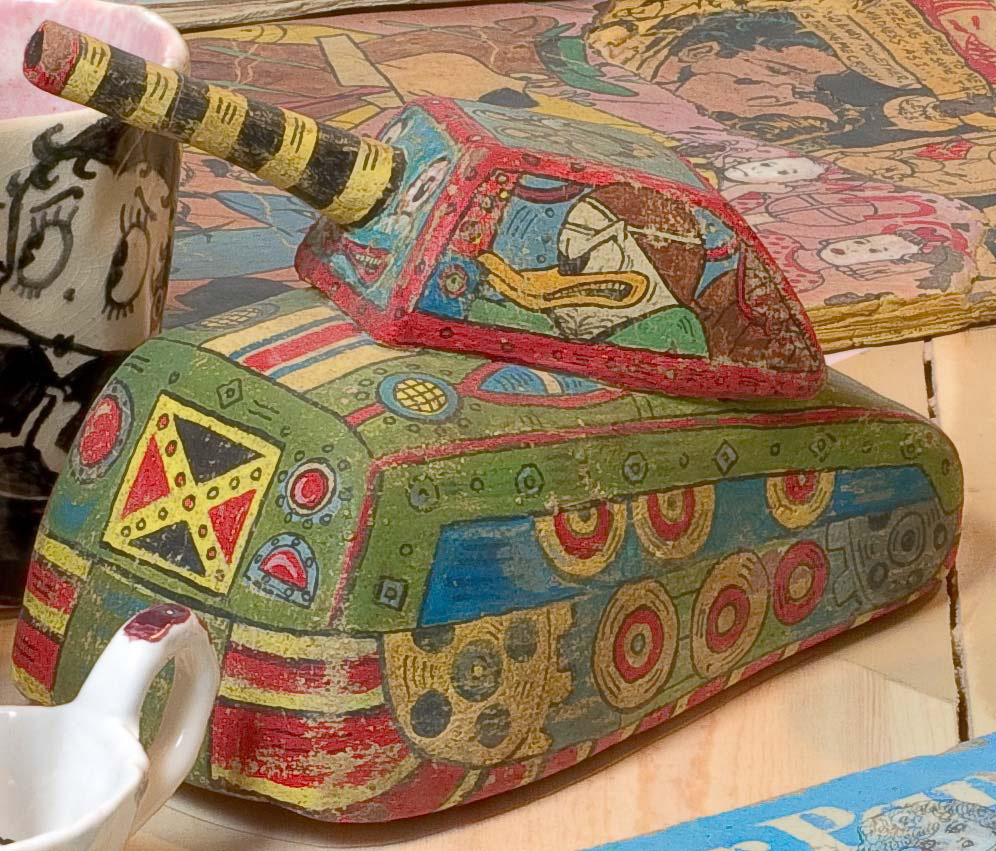
© » KADIST
Kristen Morgin
Donald of Doom Tank (2008) is a replica of a vintage metal toy with Donald Duck’s image one side and a soldier on the other. During World War II, the Walt Disney Company produced series of cartoon shorts that featured Donald Duck’s nightmare of working in an inhumane artillery factory in Nazi Germany and serving in the U. S. Army. By animating and normalizing war and military life, these cartoons not only achieved widespread popularity, but functioned as government propaganda.

© » KADIST
Dale Harding
Dale Harding’s installation Body of Objects consists of eleven sculptural works that the artist based on imagery found at sandstone sites across Carnarvon Gorge in Central Queensland. Mouth-blown with ochre on sandstone, these extraordinary stencilled images depict weaponry, domestic tools, and ceremonial objects that are specific to the region and that relate to Harding’s own ancestry. In response to these enduring indexes of Indigenous material culture, Harding produced a suite of cast objects using the stencilled imagery as a guide, along with objects that relate to his family history: boomerangs, spears, clubs, and whips are all part of the display.

© » KADIST
Jumana Manna
Blue Elbow (Coude bleu) is made from plaster, burlap, lacquer, pigments and plastics. The materials related to the techniques of the sculpture or the painting but also others, which refer to commerce, to objects of consumption. The chair refers directly to the body as does the title of the work, Blue Elbow .

© » KADIST
Mithu Sen
wombmate! by Mithu Sen is part of a project called AºVOID. In this fragmented mental map, the landscape is fleeting, embossed, and ethereal; there are moments of recognition and also a near-violent sudden emptying of memory.

© » KADIST
Elena Damiani
In Fading Fields 7 by Elena Damiani, the unstable transparency of the print on silk chiffon is relative to the light and the viewer’s position, varying continually as one moves around the work. As apparitions or ghosts, the images portrayed appear or vanish in the space as faded recollections of a distant landscape. These impressions appear as oscillatory surfaces that fluctuate between presence and absence; they are contingent objects that shift as a result of their environment.

© » KADIST
Gaëlle Choisne
Entre Chien et Loup is an installation incorporating a variety of media: rubber, discs, feathers and confetti that the artist weaves, sews and glues together. Influenced by Mike Kelley’s Memory Ware series, the artist creates an object-memory from found materials. The found objects used recall the artist’s mother – it is somehow her portrait, her cape-.

© » KADIST
Diego Bianchi
Diego Bianchi’s main concern is distorting straight lines, both literally and metaphorically. To him, deviation is the only feasible strategy to allow the unexpected to happen, making space for semantic turns, impossible encounters, and dissolving binaries. The bodily dimension appears in his art both as disturbance of the senses and perception, and as research into processes of consumerism, oppression, decomposition, and destruction.

© » KADIST
Gozo Yoshimasu
Drawing & Print (Drawing & Print)
Gozo Yoshimasu’s visual-poetry series Dear Monster (Kaibutsu-kun) explores his response to the March 2011 Tohoku earthquake and tsunami. He embarked on the project out of a deep sense of sympathy and commitment, in pursuit of “poetry possible after March 2011”, without exactly knowing where he was heading. He started scribing lines and letters on exceptionally large manuscript paper that he handcrafted every day.

© » KADIST
Yoan Capote
Open Mind is a model created by Capote for a traversable public maze that, when seen from above, resembles the human brain. Because individual movement through the maze echoes the movement of neurons and a larger aggregated whole, visitors can be seen to enact a model of sociality and public space that both embodies and metaphorizes social consciousness. Capote’s model shows not just the proposed structure, but features figurines as well, to illustrate the possible scale and interactivity of the final piece.

© » KADIST
James Welling
#17 Pink is a photogram, a photographic image produced without the use of a camera. Here, the artist placed plumbago blossoms on a sheet of eight-by-ten-inch film and exposed it to light. The negative was then projected onto Kodak Metallic Endura paper through a color mural enlarger and cooler filters to produce the multicolored print.

© » KADIST
Jonathan Monk
Untitled (rolled up) , is an abstract portrait of Owen Monk, the artist’s father and features an aluminum ring of 56.6 cm in diameter measuring 1.77 cm in circumference, the size of his father. Jonathan Monk bridges a conceptual art and his family privacy, and ironically ensures that there is “no difference between Sol Lewitt and my mother, he does not know more than she do not know. ” What is the status of the O-backed chair rail to the white cube?

© » KADIST
James Welling
Welling employs simple materials like crumpled aluminum foil, wrinkled fabric and pastry dough and directly exposes them as photograms, playing with the image in the process of revealing it. Although Welling’s approach to photography is more conceptually oriented than poetic, the resulting image in Stowe (a direct photogram of a crumpled piece of cloth) somehow resembles a curtain, perhaps suggesting that an artificial even fictive component in photographic representation. While the curtain might echo other imagery, Welling’s approach is not allegorical but rather abstract in a way that reinforces the materiality of the object.

© » KADIST
Qiu Anxiong
A Portrait: Covering and Cleaning is an installation of six black-and-white video projections. Each video depicts a portrait with features changing continuously and quickly into different persons, animals and symbols. Driven by the evolving contents of the screen itself, this piece showcases the form and material of Qiu Anxiong’s working method, which relies on precisely planned storyboard sketches drawn in pen on A4 paper.
Lisa Oppenheim
- location: New York, New York
- year born: 1975
- gender: female
- nationality: American
- home town: New York, New York
Gozo Yoshimasu
Gozo Yoshimasu is a prolific Japanese poet, photographer, artist and filmmaker active since the 1960s...
Jiri Kovanda
- location: Praha, Ceská Republika
- year born: 1953
- gender: male
- nationality: Czech
Nontawat Numbenchapol
Nontawat Numbenchapol is primarily known as a film director and television screenwriter, widely recognized for his documentary work...
Martin Kippenberger
- location: Vienna, Austria
- year born: 1953
- gender: male
- nationality: German
- home town: Dortmund, Germany
Mary Ann Aitken
Mary Ann Aitken was known to be very private about her art practice; she was considered somewhat of an outsider by her peers affiliated with the second wave of Detroit’s Cass Corridor arts movement...
James Welling
- location: New York, New York; Los Angeles, California
- year born: 1951
- gender: male
- nationality: American
- home town: Hartford, Connecticut
Sandra Monterroso
Sandra Monterroso is a Guatemalan artist of Maya Q’eqchi’ decent...
Mithu Sen
Mithu Sen’s writing is central to her practice, as a poet from West Bengal, a region of great Indian literary history, poetic and visual tropes giving ground to her challenge of semiotics...
Martin Creed
- location: Wakefield, United Kingdom
- year born: 1968
- gender: male
- nationality: British
Diane Severin Nguyen
Diane Severin Nguyen collects found objects and organic matter to craft the images in her photographs and video works...
Fernanda Laguna
Fernanda Laguna has mobilized and influenced a whole generation of artists through her various projects since the mid-1990s...
Baseera Khan
Designed by the artist and fabricated in collaboration with Kashmiri artisans, Baseera Khan’s Psychedelic Prayer Rugs combine visual iconography traditional to Islam, such as the crescent moon and lunar calendar, with brightly colored symbols of personal significance to the artist: a pair of embroidered sneakers, a fragment of an Urdu poem, and the Purple Heart medal...
David Haxton
Although trained as a painter, David Haxton is known for his exploration of light through the mediums of photography and film...
Sheroanawe Hakihiiwe
Sheroanawe Hakihiiwe is a Yanomami artist who lives and works in Upper Orinoco, at the Venezuelan side of the Amazon rainforest...
Dale Harding
A descendant of the Bidjara, Ghungalu, and Garingbal peoples, Dale Harding’s work references and expands upon the philosophical and spiritual touchstones of his cultural inheritance...
Jonathan Monk
- location: Berlin, Germany
- year born: 1969
- gender: male
- nationality: British
- home town: Leicester, United Kingdom
Kitty Kraus
Kitty Krauss has a very particular outlook on Minimal and Constructivist Art...
Julia Rommel
Julia Rommel (b...
Chris Wiley
- location: New York, New York
- year born: 1981
- gender: male
- nationality: British
Xiaoyun Chen
- location: Hangzhou, China
- year born: 1971
- gender: male
- nationality: Chinese
- home town: Hubei Province, China
Elena Damiani
- location: Copenhagen, Denmark
- location: Lima, Peru
- year born: 1972
- gender: female
- nationality: Peruvian
- home town: Peru
Alicia Henry
Alicia Henry creates work that departs from Western ideas of portraiture, which denote a likeness or a construction of a subject...
Lotus Laurie Kang
Lotus Laurie Kang works with sculpture, photography, and site-responsive installation...
Julian Hoeber
- location: Los Angeles, California
- year born: 1974
- gender: male
- nationality: American
- home town: Philadelphia, Pennsylvania
Pablo Accinelli
- year born: 1983
- gender: male
- nationality: Argentinian
Naama Tsabar
Naama Tsabar is an Israel-born, New York-based sculpture artist...
Zhu Changquan
Zhu Changquan engages in artistic activities through analyzing everyday life...
-
1970-1979
David Haxton
197016 films is a selection of David Haxton’s single-screen videos, which he began producing in the 1970s as a continuation of some of the conceptual underpinnings of his earlier film installations...
Eleanor Antin
1973Comprised of fifty-one photographic postcards, Antin’s 100 Boots is an epic visual narrative in which 100 black rubber boots stand in for a fictional “hero” making a “trip” from California to New York City...
-
1980-1989
Jiri Kovanda
1980Kovanda’s street interventions are always documented according to the same format as the actions: a piece of A4 paper, a typewritten text giving a precise location and date, and a photograph...
Jiri Kovanda
1980Kovanda’s street interventions are always documented according to the same format as the actions: a piece of A4 paper, a typewritten text giving a precise location and date, and a photograph...
Jiri Kovanda
1980Kovanda’s street interventions are always documented according to the same format as the actions: a piece of A4 paper, a typewritten text giving a precise location and date, and a photograph...
Martin Kippenberger
1988Martin Kippenberger’s late collages are known for incorporating a wide range of materials, from polaroids and magazine clips to hotel stationery, decals, and graphite drawings...
Martin Kippenberger
Drawing & Print
1989(Drawing & Print) Untitled is a work on paper by Martin Kippenberger comprised of several seemingly disparate elements: cut-out images of a group of dancers, a japanese ceramic vase, and a pair of legs, are all combined with gestural, hand-drawn traces and additional elements such as a candy wrapper from a hotel in Monte Carlo and a statistical form from a federal government office in Wiesbaden, Germany...
-
1990-1999
Mike Kelley
1996Towhead n’Ganga, enclosed in darkness, lorded over by the sexualized folded high priestless form reflects many of Kelley’s works, in both its compositional and semantic qualities...
-
2000-2009
Mary Ann Aitken
2002Untitled (Boom Box, Double-Sided) by Mary Ann Aitken is representational painting of a boom box on an unconventionally long canvas painted on both sides, to mimic the scale and appearance of the actual appliance...
Martin Creed
2003This photograph of Martin Creed himself was used as the invitation card for a fundraising auction of works on paper at Christie’s South Kensington in support of Camden Arts Centre’s first year in a refurbished building in 2005...
Jonathan Monk
2003Untitled (rolled up) , is an abstract portrait of Owen Monk, the artist’s father and features an aluminum ring of 56.6 cm in diameter measuring 1.77 cm in circumference, the size of his father...
Lisa Oppenheim
Drawing & Print
2003(Drawing & Print) The Damaged series by Lisa Oppenheim takes a series of selected photographs from the Chicago Daily News (1902 – 1933) as its source material...
Lisa Oppenheim
Drawing & Print
2003(Drawing & Print) The Damaged series by Lisa Oppenheim takes a series of selected photographs from the Chicago Daily News (1902 – 1933) as its source material...
Lisa Oppenheim
Drawing & Print
2003(Drawing & Print) The Damaged series by Lisa Oppenheim takes a series of selected photographs from the Chicago Daily News (1902 – 1933) as its source material...
James Welling
2005#17 Pink is a photogram, a photographic image produced without the use of a camera...
David Haxton
2005In the mid to late 70s David Haxton turned to photography, and similarly to his output in film, his photographs show reverberations of his perspective as a painter...
James Welling
2006Welling employs simple materials like crumpled aluminum foil, wrinkled fabric and pastry dough and directly exposes them as photograms, playing with the image in the process of revealing it...
Yoan Capote
2007Open Mind is a model created by Capote for a traversable public maze that, when seen from above, resembles the human brain...
Kadar Brock
2007Kadar Brock creates dynamic abstract paintings that are born from a process of painting, scraping, priming, sanding, and painting again...
Kristen Morgin
2008Donald of Doom Tank (2008) is a replica of a vintage metal toy with Donald Duck’s image one side and a soldier on the other...
Zhang Peili
2008In the video installation A Gust of Wind , Zhang continues to explore notions of perspective and melds them seamlessly with a veiled but incisive social critique...
Kristen Morgin
2008Jeep Comics is based on the second of only two issues published by RB Leffingwell and Company in 1944–45...
Jedediah Caesar
2009For Untitled, Caesar encased recycled objects such as scraps of plywood, paper or cloth in resin and then cut and reassembled the pieces into abstract forms...
Mary Ann Aitken
2009Untitled (Diptych) by Mary Ann Aitken is a pair of paintings; one entirely abstract and the other a hybrid of representational and abstract elements...
-
2010-2019
Nao Bustamante
2010Silver & Gold combines video, performance, and original costumes into a self-proclaimed “filmformance” that evokes the legendary filmmaker Jack Smith and his tribute to 1940s Dominican movie starlet Maria Montez in a magical and joyfully twisted exploration of race, glamour, sexuality, and the silver screen...
Nathaniel Dorsky
2010Dorsky’s pieces included in the Kadist Collection are small still photographs from twelve of his most important films...
Marcelo Cidade
2010Adição por subtração 4 (Addition by Subtraction, 2010) is an intervention into the white cube with both beautiful and intimidating results...
Chris Duncan
2010Taken from the title of the incredibly influential punk/hardcore record I AGAINST I by the Bad Brains, Untitled (blue) is an acrylic painting on reflective paper by Chris Duncan is part of a larger body of work titled EYE AGAINST I ...
Walead Beshty
2010Black Curl (CMY/Five Magnet: Irvine, California, March 25, 2010, Fujicolor Cyrstal Archive Super Type C, EM No 165-021, 05910) is a visually compelling photogram...
Qiu Anxiong
2011A Portrait: Covering and Cleaning is an installation of six black-and-white video projections...
Julian Hoeber
2011Every work in Hoeber’s 2011 series Execution Changes is titled in alphanumeric code...
Phi Phi Oanh
2011Palimpsest is a series of what artist Phi Phi Oanh calls “pictorial installations”...
Pablo Accinelli
2011In Onde quer que voce esteja (2011) Accinelli sets up a row of cardboard shipping tubes of varying heights and inscribes on them in black ink the words of the title, which translates in English as “Wherever you may be.” The words, while legible, seem like fragmented lines and shapes—almost but not quite a deconstruction of the text...
Xiaoyun Chen
2012The lengthy titles in Chen Xiaoyun’s work often appear as colophons to his photographs that invite the viewer to a process of self realization through contemplating the distance between word and image...
Chris Wiley
2012Architectural details become abstracted renderings in Chris Wiley’s inkjet prints 11 and 20 (both 2012)...
Santiago Borja
2012Cosmic Tautology I and II are two textile pieces representative of Santiago Borja’s practice and long-standing interest in disrupting universalist assumptions of minimalism by connecting them with other, non-Western or esoteric references...
James Collins
2013These two large format untitled paintings by James Collins feature the artist’s hallmark technique, which transforms abstraction into an optical illusion that creates dimension, space, and mass...
Elena Damiani
2014In Fading Fields 7 by Elena Damiani, the unstable transparency of the print on silk chiffon is relative to the light and the viewer’s position, varying continually as one moves around the work...
Gozo Yoshimasu
Drawing & Print
2014(Drawing & Print) Gozo Yoshimasu’s visual-poetry series Dear Monster (Kaibutsu-kun) explores his response to the March 2011 Tohoku earthquake and tsunami...
Oscar Tuazon
2014Oscar Tuazon‘s sculptural oeuvre is situated at the border of art, architecture and technology...
Gozo Yoshimasu
Drawing & Print
2014(Drawing & Print) Gozo Yoshimasu’s visual-poetry series Dear Monster (Kaibutsu-kun) explores his response to the March 2011 Tohoku earthquake and tsunami...
Fabien Giraud & Raphael Siboni
2014– Thisstoryoffriedrichkurzweiliwanttotellit- myselfhowhelivedinthisroomandh – Inspired by the writings of the feral child Kaspar Hauser and told by the young Friedrich, both father and son of Ray Kurzweil, this story unfolds on the microscope images of a blade cutting through metal...
Francisco Herrero Peñuela
2014Francisco Herrero Peñuela uses old forms to make his elaborate, richly textured surfaces...
Jumana Manna
2015Blue Elbow (Coude bleu) is made from plaster, burlap, lacquer, pigments and plastics...
Gaëlle Choisne
2015Entre Chien et Loup is an installation incorporating a variety of media: rubber, discs, feathers and confetti that the artist weaves, sews and glues together...
Maria Fernanda Plata
2015Unraveling, or “unweaving” sections of fabric, Maria Fernanda Plata arrived at delicate and tenuous-looking forms, both ghostly and gentle...
Erika Verzutti
2015Made in cast bronze, Two Eyes Two Mouths provokes a strong sense of fleshiness as if manipulated by the hand of the artist pushing her fingers into wet clay or plaster to create gouges that represent eyes, mouths and the female reproductive organ...
Julia Rommel
2015On the artwork, Rommel states: “I was reading Jonathan Franzen’s new novel Purity, where they take a lot of walks through the jungle in Uruguay, or Paraguay, I can’t remember...
Fernando Palma Rodríguez
2015Aqua by Fernando Palma Rodríguez is an installation formed by four gourds and one movement detector that activates them...
Matthew Langan-Peck
2016Plane is an inflatable sculpture in the shape of an aeroplane made from numerous pieces of plastic bags assembled by an iron...
Wade Guyton
Drawing & Print
2016(Drawing & Print) This untitled print by Wade Guyton depicts an iteration of elements that are characteristic of the artist’s work...
Eileen Quinlan
2016Eileen Quinlan’s abstracted images, like Swipe , rely on the manipulation of photographic materials inside the studio itself, and reject the exterior world for complex interrogations of the medium....
Lu Pingyuan
2016Masterpiece in the Water by Lu Pingyuan tells the story of an impatient collector who is killed by an artist...
Haegue Yang
2016A steel clothing rack adorned with turbine vents, Moroccan vintage jewelry, pinecones and knitting yarn, these heterogeneous elements are used here to create an exotic yet undefined identity within the work...
Baseera Khan
2017Designed by the artist and fabricated in collaboration with Kashmiri artisans in India, Baseera Khan’s Psychedelic Prayer Rugs combine visual iconography traditional to Islam, such as the crescent moon and lunar calendar, with brightly coloured symbols of personal significance to the artist: a pair of embroidered sneakers, a fragment of an Urdu poem, and the Purple Heart medal...
Markus Amm
2017A combination of planning and improvisation, control and lack of control, this painting is typical of Amm’s work...
Laura Gannon
2017The impressionistic surface of Wild Money (2017) recalls the 1950s paintings of Philip Guston...
Antonio Pichillá
2017Wind by Antonio Pichillá is a textile piece depicting the glyph that represents the element wind in the Mayan tradition...
Baseera Khan
2017Designed by the artist and fabricated in collaboration with Kashmiri artisans in India, Baseera Khan’s Psychedelic Prayer Rugs combine visual iconography traditional to Islam, such as the crescent moon and lunar calendar, with brightly coloured symbols of personal significance to the artist: a pair of embroidered sneakers, a fragment of an Urdu poem, and the Purple Heart medal...
Wolfgang Tillmans
2017Wolfgang Tillmans initiated the ongoing series Faltenwurf in 1989, representing compositions of unused clothing, with special attention paid to the ways in which they drape and fold...
Gozo Yoshimasu
Drawing & Print
2017(Drawing & Print) Gozo Yoshimasu’s double-sided work on paper Fire Embroidery explores his response to the March 2011 Tohoku earthquake and tsunami...
Curtis Talwst Santiago
2017Curtis Talwst Santiago has been creating intimate and performative environments within these small spaces for several years; the artist used to carry them around to show visitors one on one, opening up a scene in the space of his hand...
Fernanda Laguna
2017Llorar mucho (To Cry A Lot) is representative of Fernanda Laguna’s practice of the past twenty years...
Seulgi Lee
2018The Korean title for U: Repair the cowshed after losing the cow = Too late is —a famous Korean proverb meaning “you are doing something when you are already late to do it”...
Dale Harding
2018Dale Harding’s installation Body of Objects consists of eleven sculptural works that the artist based on imagery found at sandstone sites across Carnarvon Gorge in Central Queensland...
Andrew Ekins
2018Butter Mountain is part of an ongoing series of works that combines a sense of painterly mass and substance with sculptural language to examine the synergy between a topographical landscape and a landscape of the human condition...
Fernanda Laguna
2018¡Qué triste estoy! (I’m So Sad) is representative of Fernanda Laguna’s practice of the past twenty years...
Auriea Harvey
2018Fauna is a figurative sculpture by Auriea Harvey that is characteristic of the artist’s practice—both serious and somewhat whimsical...
Alicia Henry
2019Out of simple materials, Alicia Henry creates enigmatic, somewhat troubled characters, which reveal her interest in the complexities and the contradictions surrounding familial relationships...
Diego Bianchi
2019Diego Bianchi’s main concern is distorting straight lines, both literally and metaphorically...
Rachel Rose
2019First Born by Rachel Rose is part of a series of works titled Borns which expands on the artist’s longstanding interest in the organic shape of eggs...
Sheroanawe Hakihiiwe
2019Wateoma husipe / Larvas de oruga / Caterpillar larvae by Sheroanawe Hakihiiwe exemplify his most abstract work, where he choses particular elements of a living organism to create his renditions...
Egle Jauncems
2019The title of this work by Egle Jauncems, The Paler King I , is taken from an unfinished novel by the late David Foster Wallace called The Pale King, published posthumously in 2015...
Minia Biabiany
2019Qui vivra verra, Qui mourra saura is an installation by Minia Biabiany composed of the plan of a house made out of strips of salt, and a “garden” made of ceramic pieces, hanging from the ceiling and on the floor, and non woven fabric...
Tanatchai Bandasak
2019Central Region by Tanatchai Bandasak is a meditation on materiality and time-based media centres on the mysterious, prehistoric ‘standing stones’ of Hintang in Northern Laos: little-studied megaliths which have survived thousands of years of political change and the cataclysmic carpet-bombing of Laos by the United States during the Cold War...
Diane Severin Nguyen
2019To produce her photo and film works, Diane Severin Nguyen makes amalgam sculptures from found materials, both natural and synthetic...
Sheroanawe Hakihiiwe
2019Perawesi / Estómago de animal / Stomach of animal by Sheroanawe Hakihiiwe exemplify his most abstract work, where he choses particular elements of a living organism to create his renditions...
-
2020-2029
Zhu Changquan
2020In Dark Beyond Deep by Zhu Changquan the film presents the process of how consciousness gradually develops and extends from the real world to virtual space through a raven named Cyma...
rafa esparza
2020thanks for staying alive Fern.1994 by rafa esparza is from a body of work that pays homage to youth culture in the 90s...
Nikita Gale
2020RUINER III by Nikita Gale is part of an on-going numbered series of abstract sculptures in which various ancillary materials necessary for sound production and recording such as towels, foam, and audio cables, are riddled around piping resembling crowd control bollards, lighting trusses, and other like stage architecture...
Diane Severin Nguyen
2020To produce her photo and film works, Diane Severin Nguyen makes amalgam sculptures from found materials, both natural and synthetic...
Rahima Gambo
2020“ I think we are oversaturated, filled to the brim with images in our inner subconscious eye...
Catalina Ouyang
2021font VII by Catalina Ouyang is part of an ongoing series of ‘fonts’, or sculptures, inspired by Catholic holy water vessels...
Phoebe Collings-James
2021The Subtle Rules the Dense is a series of masks/torsos/body plates that Phoebe Collings-James cast from mannequins and then worked by hand...
Nikau Hindin
2021Maori barkcloth making is the central artistic form in the Pacific, and still at the core of cultural expression in many Pacific countries...
Pichet Piaklin
2021The Wings by Pichet Piaklin is a creation story of fragility, where the desire for freedom is mired in blood red by the inculcation of faith and violence...
Cross Lypka
2022tombs and ignitions is a collaborative ceramic sculpture by artists Tyler Cross and Kyle Lypka...
Yuyan Wang
2022One Thousand and One Attempts to Be an Ocean by Yuyan Wang reflects on the experience of not being able to see the world with depth perception...
Anju Dodiya
2022The Shedding by Anju Dodiya is part of a series of mattress paintings the artist creates using fabric stretched on padded and shaped boards...
Caspar Heinemann
2022Glorie #7 by Caspar Heinemann is made from cardboard boxes in which the artist received deliveries at home during lockdown, as well as other materials that he uses in an improvisatory way...
Jared Owens
2022Hog feed 102 is an exemplary work by Jared Owens that combines two of the artist’s primary signatures: the use of soil smuggled out of the grounds at F...
Risham Syed
2022Risham Syed discovered a box of woven Chinese silk panels that was her mother’s most prized possession...
Sandra Monterroso
2022Sandra Monterroso’s video performance titled Corazón del lugar del viento (Heart of the Place of the Wind) is inspired by Seis Cielo (Six Sky), the only female Mayan ruler to be represented in classical Mayan stelae (historical monuments dedicated to the record of important events)...
Lotus Laurie Kang
2022Scaffold by Lotus Laurie Kang features a seemingly disjointed amalgamation of materials between flat fabrics and lumps of aluminum...
Sandra Monterroso
Drawing & Print
2023(Drawing & Print) Presented as part of a recent group of works titled The Paradox of Healing, Rhombus for Healing No...














